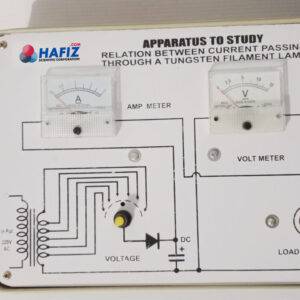Description
🔦 Neon Flash Lamp with Mega Ohm Resistance Selector
The Neon Flash Lamp with Mega Ohm Resistance Selector is an essential apparatus for demonstrating time-dependent electrical discharge phenomena in RC circuits. Ideal for educational physics labs, this equipment enables the practical study of capacitor charging and discharging cycles through visual cues—specifically, the periodic flashing of a neon lamp.
This setup typically includes:
-
Neon Flash Lamp: A gas-discharge lamp that lights up once the voltage across the capacitor exceeds the lamp’s breakdown voltage (usually ~70-90V). It flashes, discharges the capacitor, and turns off until the next cycle begins.
-
High-Voltage Power Supply: Operates safely on 220V AC (50–60 Hz) and is built to sustain long-term lab use.
-
Capacitor (in µF): Stores charge over time until the threshold is reached.
-
Mega Ohm Resistance Selector (R. Selector): A switchable bank of high-value resistors, typically ranging from 0.1 MΩ to 10 MΩ or more. It controls how quickly the capacitor charges, thereby altering the flashing frequency.
This apparatus elegantly demonstrates exponential charging, time constant (τ = RC), and electrical relaxation oscillations, allowing users to calculate unknown resistance values by observing flash intervals. It’s a popular tool for A-Level physics, electronics demonstrations, and undergraduate circuit labs.
🔍 How It Works:
-
When the circuit is powered, the capacitor begins to charge through the selected resistance.
-
Once the voltage across the capacitor reaches the firing voltage of the neon lamp, it conducts, emitting a flash.
-
The lamp discharges the capacitor almost instantaneously.
-
The capacitor then begins charging again, and the cycle repeats.
🎯 Educational Applications:
-
RC Time Constant Measurements
-
Study of Capacitor Charging/Discharging
-
Observing Threshold and Breakdown Behavior
-
Measuring Unknown Resistance Using Flash Frequency
-
Demonstrating Relaxation Oscillators in Action
📦 Specifications:
-
Resistance Range: Up to 10 MΩ with switchable increments
-
Power Supply: 220V AC ±10%, 50–60Hz
-
Neon Lamp Firing Voltage: ~70–90V
-
Capacitor Range: 1 µF to 10 µF (depends on model)
-
Output: Visual flash output, frequency dependent on RC value
-
Build Quality: Rugged housing, suitable for classroom use
❓ FAQs – Neon Flash Lamp with Mega Ohm R.Slector
Q1. What is the function of the Mega Ohm Resistance Selector?
A: It adjusts the resistance in the RC circuit to control the flash frequency of the neon lamp. Higher resistance slows the charging rate of the capacitor, leading to slower flashing.
Q2. Can this apparatus be used to measure unknown resistance?
A: Yes. By adjusting the resistor and measuring the time between flashes, users can determine the time constant and calculate unknown resistances using τ = RC [2].
Q3. Is it safe to use in classrooms?
A: Absolutely. The system is enclosed in an insulated body and operates at a controlled high voltage, designed specifically for physics lab demonstrations [3].
Q4. What is the typical flash interval range?
A: The flash interval can range from less than 1 second to over 10 seconds, depending on the resistor and capacitor combination selected.
Q5. Can I use different capacitors with this device?
A: Yes, many models allow switching or replacing the capacitor to study different time constants.
Q6. What maintenance does the device require?
A: Minimal. Ensure proper connection, dust-free environment, and replace neon lamps only if they burn out after extensive use.
Q7. Does it require a stopwatch?
A: While not mandatory, a stopwatch helps in timing flash intervals precisely during experiments to calculate resistance values [3].
Q8. How does the neon lamp “know” when to flash?
A: It flashes when the voltage across it exceeds its breakdown (firing) voltage, discharging the capacitor rapidly [4].
Q9. Is the device portable?
A: Yes, it’s compact and lightweight, making it ideal for lab rotations and physics demonstrations.
Q10. Can students safely handle it?
A: Yes, under teacher supervision, as the exposed components are minimal and it operates in a controlled environment.





Reviews
There are no reviews yet.